Page 536 of 650
536
5-2. Steps to take in an emergency
If you have a flat tire (vehicles with spare tire)
Remove the flat tire and replace it with the spare provided.
Before jacking up the vehicle
Stop the vehicle on a hard, flat surface.
Set the parking brake.
Shift the shift lever to “P” (Multidrive or automatic transmis-
sion) or “R” (manual transmission).
Stop the engine.
Turn on the emergency flashers. (P. 502)
Location of the spare tire, jack and tools
Vehicles without the third seat
Spare tire
Jack
handleJack
Wheel nut wrench
Towing eyelet
VERSO_WE.book Page 536 Thursday, June 19, 2014 11:31 AM
Page 549 of 650
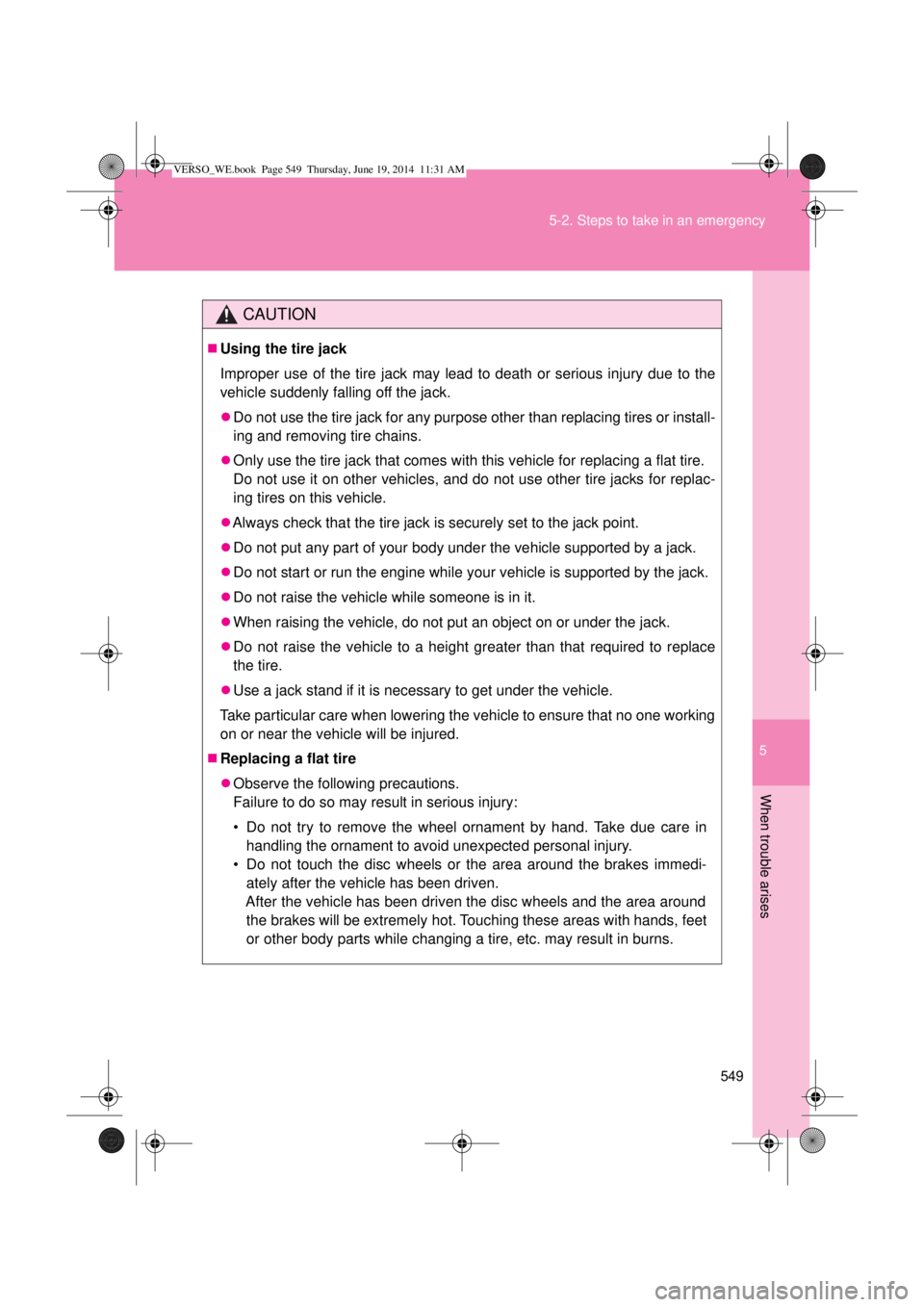
5
549 5-2. Steps to take in an emergency
When trouble arises
CAUTION
Using the tire jack
Improper use of the tire jack may lead to death or serious injury due to the
vehicle suddenly falling off the jack.
Do not use the tire jack for any purpose other than replacing tires or install-
ing and removing tire chains.
Only use the tire jack that comes with this vehicle for replacing a flat tire.
Do not use it on other vehicles, and do not use other tire jacks for replac-
ing tires on this vehicle.
Always check that the tire jack is securely set to the jack point.
Do not put any part of your body under the vehicle supported by a jack.
Do not start or run the engine while your vehicle is supported by the jack.
Do not raise the vehicle while someone is in it.
When raising the vehicle, do not put an object on or under the jack.
Do not raise the vehicle to a height greater than that required to replace
the tire.
Use a jack stand if it is necessary to get under the vehicle.
Take particular care when lowering the vehicle to ensure that no one working
on or near the vehicle will be injured.
Replacing a flat tire
Observe the following precautions.
Failure to do so may result in serious injury:
• Do not try to remove the wheel ornament by hand. Take due care in
handling the ornament to avoid unexpected personal injury.
• Do not touch the disc wheels or the area around the brakes immedi-
ately after the vehicle has been driven.
After the vehicle has been driven the disc wheels and the area around
the brakes will be extremely hot. Touching these areas with hands, feet
or other body parts while changing a tire, etc. may result in burns.
VERSO_WE.book Page 549 Thursday, June 19, 2014 11:31 AM
Page 551 of 650
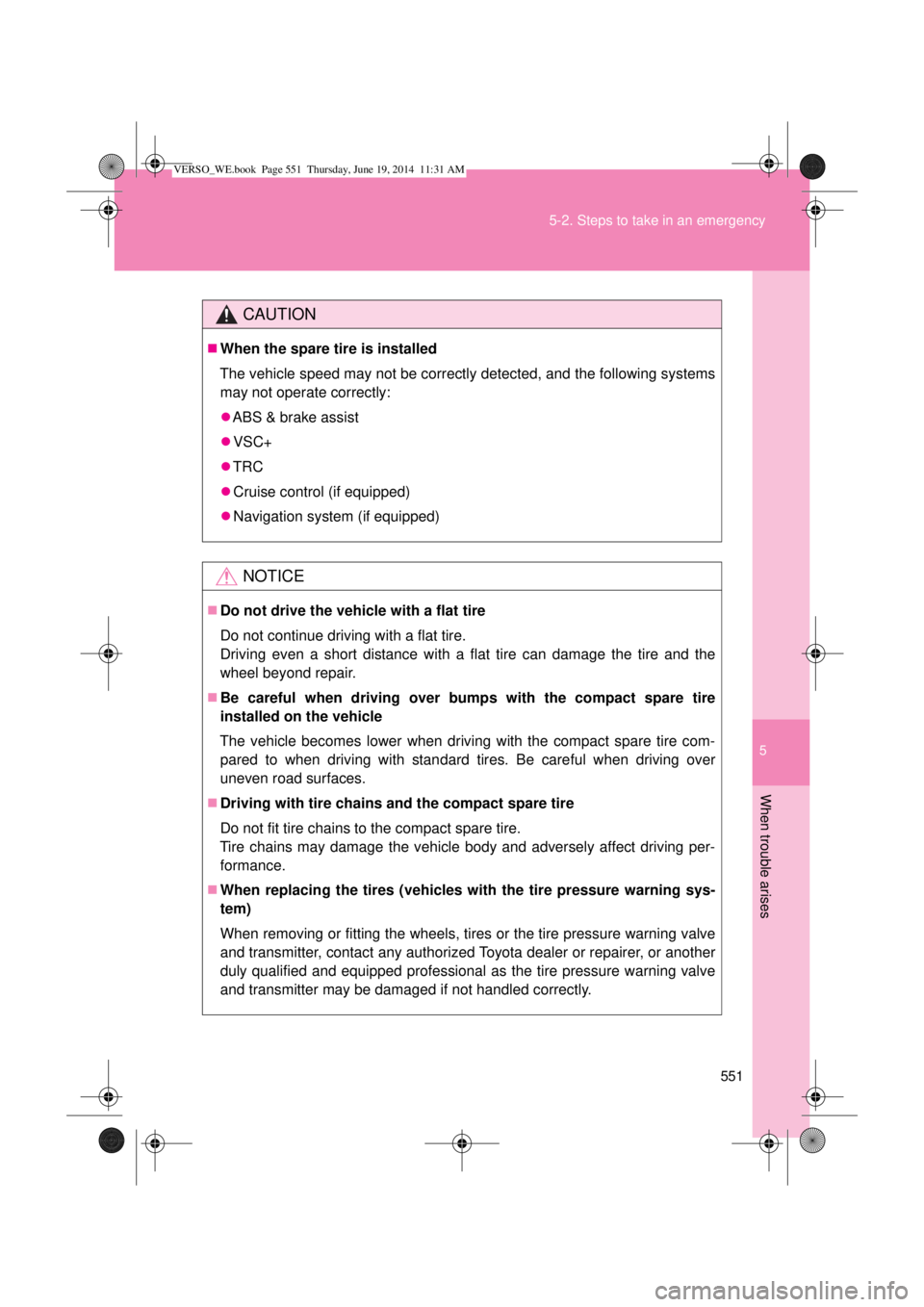
5
551 5-2. Steps to take in an emergency
When trouble arises
CAUTION
When the spare tire is installed
The vehicle speed may not be correctly detected, and the following systems
may not operate correctly:
ABS & brake assist
VSC+
TRC
Cruise control (if equipped)
Navigation system (if equipped)
NOTICE
Do not drive the vehicle with a flat tire
Do not continue driving with a flat tire.
Driving even a short distance with a flat tire can damage the tire and the
wheel beyond repair.
Be careful when driving over bumps with the compact spare tire
installed on the vehicle
The vehicle becomes lower when driving with the compact spare tire com-
pared to when driving with standard tires. Be careful when driving over
uneven road surfaces.
Driving with tire chains and the compact spare tire
Do not fit tire chains to the compact spare tire.
Tire chains may damage the vehicle body and adversely affect driving per-
formance.
When replacing the tires (vehicles with the tire pressure warning sys-
tem)
When removing or fitting the wheels, tires or the tire pressure warning valve
and transmitter, contact any authorized Toyota dealer or repairer, or another
duly qualified and equipped professional as the tire pressure warning valve
and transmitter may be damaged if not handled correctly.
VERSO_WE.book Page 551 Thursday, June 19, 2014 11:31 AM
Page 552 of 650
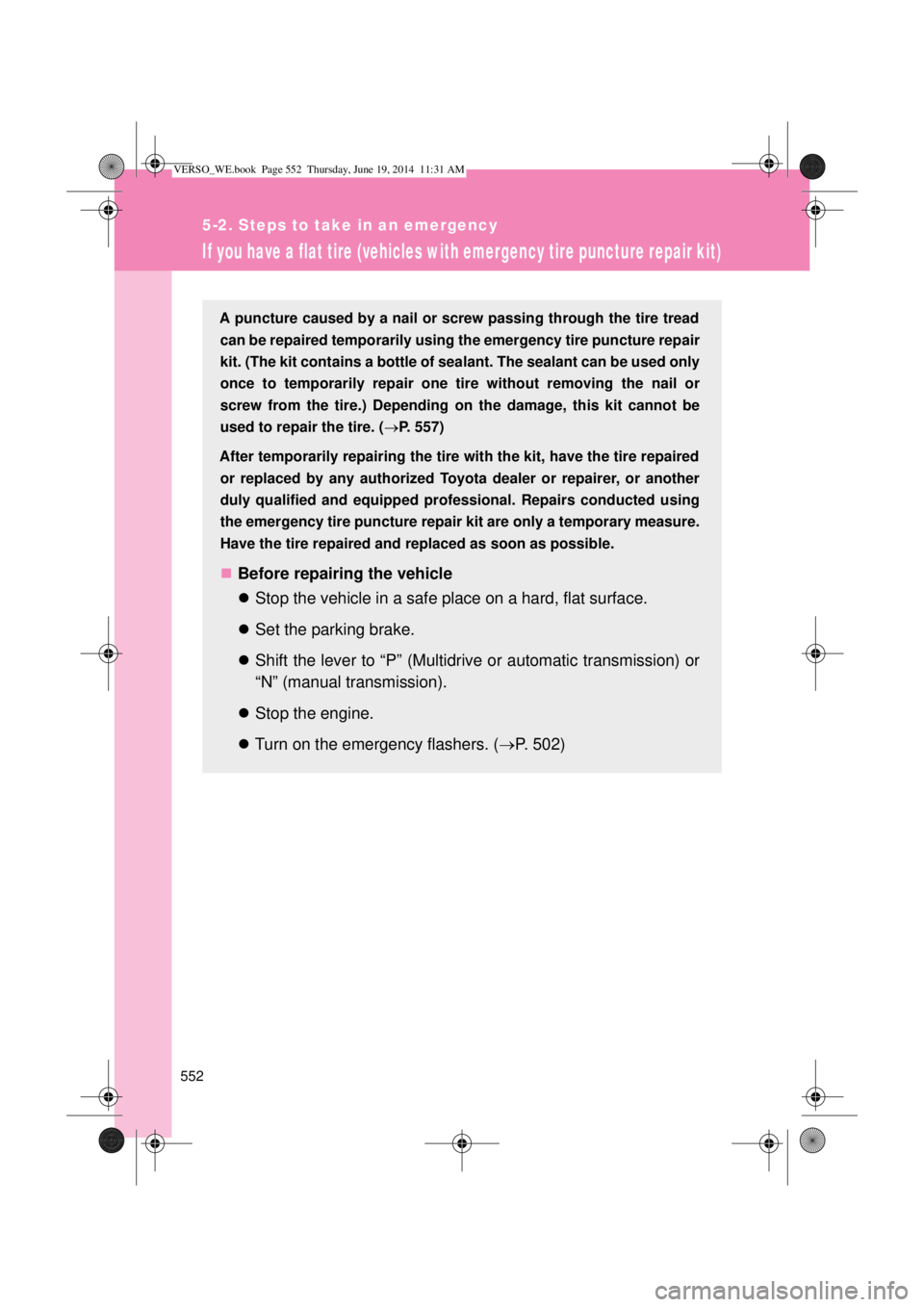
552
5-2. Steps to take in an emergency
If you have a flat tire (vehicles with emergency tire puncture repair kit)
A puncture caused by a nail or screw passing through the tire tread
can be repaired temporarily using the emergency tire puncture repair
kit. (The kit contains a bottle of sealant. The sealant can be used only
once to temporarily repair one tire without removing the nail or
screw from the tire.) Depending on the damage, this kit cannot be
used to repair the tire. (P. 557)
After temporarily repairing the tire with the kit, have the tire repaired
or replaced by any authorized Toyota dealer or repairer, or another
duly qualified and equipped professional. Repairs conducted using
the emergency tire puncture repair kit are only a temporary measure.
Have the tire repaired and replaced as soon as possible.
Before repairing the vehicle
Stop the vehicle in a safe place on a hard, flat surface.
Set the parking brake.
Shift the lever to “P” (Multidrive or automatic transmission) or
“N” (manual transmission).
Stop the engine.
Turn on the emergency flashers. (P. 502)
VERSO_WE.book Page 552 Thursday, June 19, 2014 11:31 AM
Page 573 of 650
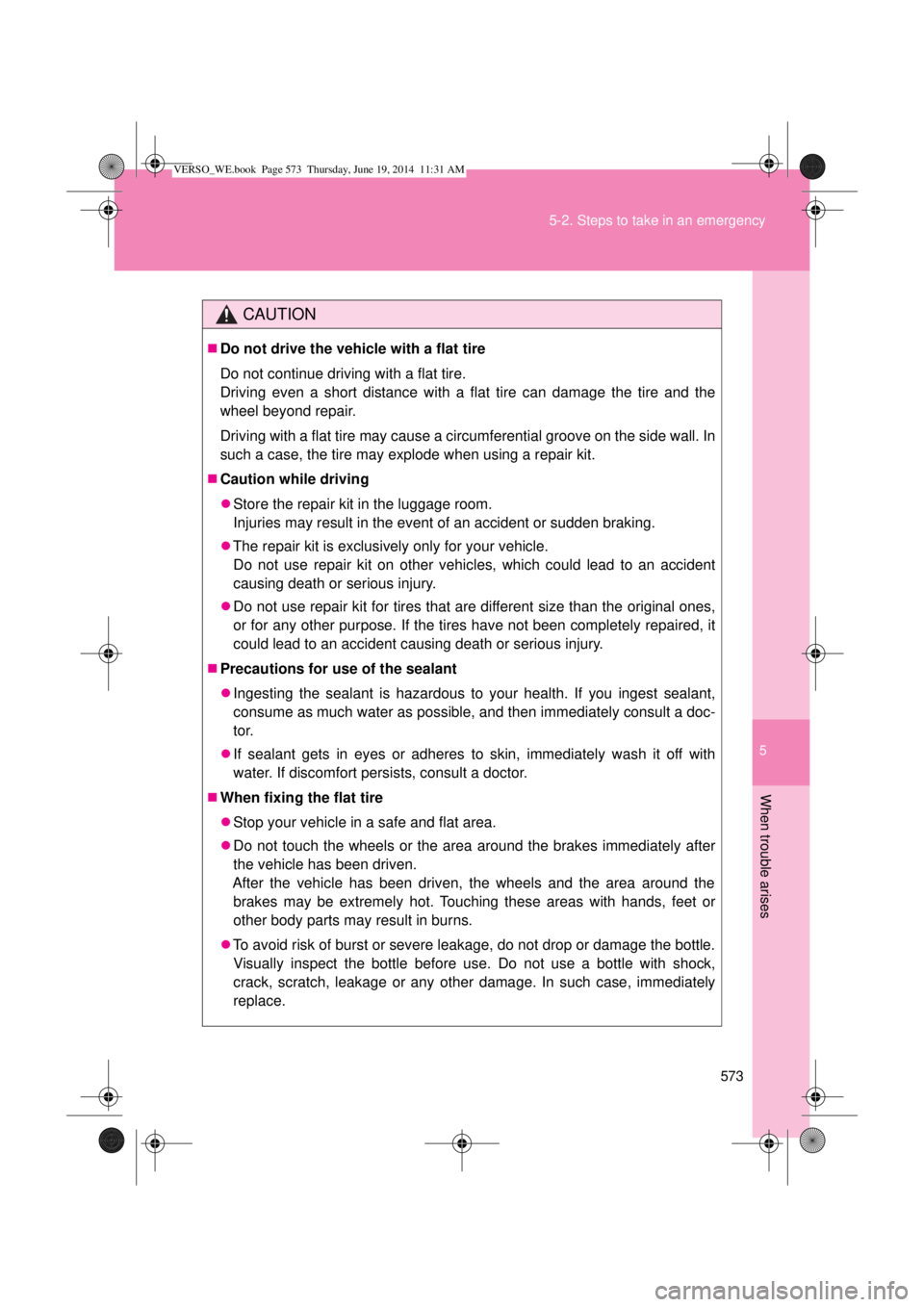
5
573 5-2. Steps to take in an emergency
When trouble arises
CAUTION
Do not drive the vehicle with a flat tire
Do not continue driving with a flat tire.
Driving even a short distance with a flat tire can damage the tire and the
wheel beyond repair.
Driving with a flat tire may cause a circumferential groove on the side wall. In
such a case, the tire may explode when using a repair kit.
Caution while driving
Store the repair kit in the luggage room.
Injuries may result in the event of an accident or sudden braking.
The repair kit is exclusively only for your vehicle.
Do not use repair kit on other vehicles, which could lead to an accident
causing death or serious injury.
Do not use repair kit for tires that are different size than the original ones,
or for any other purpose. If the tires have not been completely repaired, it
could lead to an accident causing death or serious injury.
Precautions for use of the sealant
Ingesting the sealant is hazardous to your health. If you ingest sealant,
consume as much water as possible, and then immediately consult a doc-
tor.
If sealant gets in eyes or adheres to skin, immediately wash it off with
water. If discomfort persists, consult a doctor.
When fixing the flat tire
Stop your vehicle in a safe and flat area.
Do not touch the wheels or the area around the brakes immediately after
the vehicle has been driven.
After the vehicle has been driven, the wheels and the area around the
brakes may be extremely hot. Touching these areas with hands, feet or
other body parts may result in burns.
To avoid risk of burst or severe leakage, do not drop or damage the bottle.
Visually inspect the bottle before use. Do not use a bottle with shock,
crack, scratch, leakage or any other damage. In such case, immediately
replace.
VERSO_WE.book Page 573 Thursday, June 19, 2014 11:31 AM
Page 577 of 650
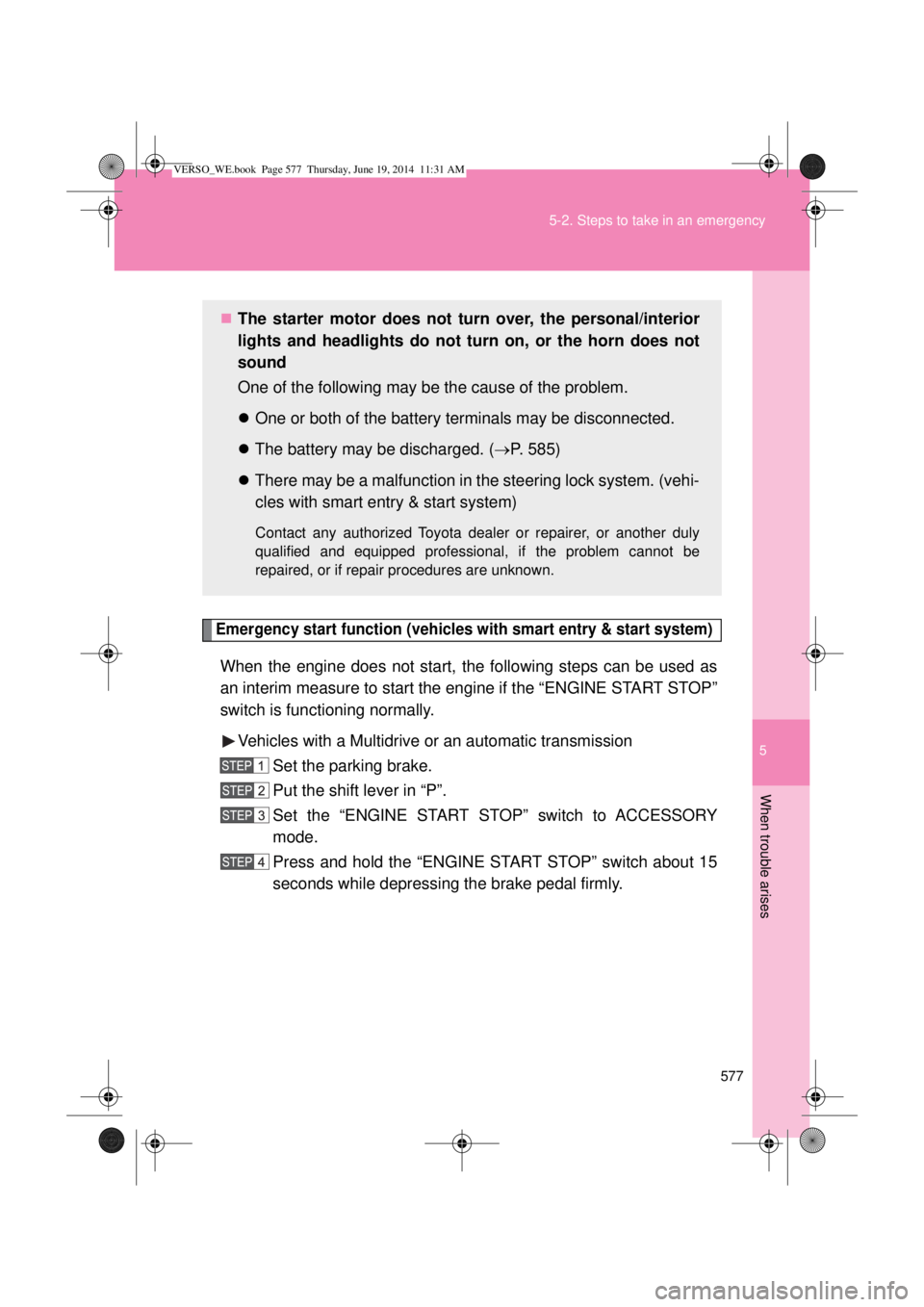
5
577 5-2. Steps to take in an emergency
When trouble arises
Emergency start function (vehicles with smart entry & start system)
When the engine does not start, the following steps can be used as
an interim measure to start the engine if the “ENGINE START STOP”
switch is functioning normally.
Vehicles with a Multidrive or an automatic transmission
Set the parking brake.
Put the shift lever in “P”.
Set the “ENGINE START STOP” switch to ACCESSORY
mode.
Press and hold the “ENGINE START STOP” switch about 15
seconds while depressing the brake pedal firmly.
The starter motor does not turn over, the personal/interior
lights and headlights do not turn on, or the horn does not
sound
One of the following may be the cause of the problem.
One or both of the battery terminals may be disconnected.
The battery may be discharged. (P. 585)
There may be a malfunction in the steering lock system. (vehi-
cles with smart entry & start system)
Contact any authorized Toyota dealer or repairer, or another duly
qualified and equipped professional, if the problem cannot be
repaired, or if repair procedures are unknown.
VERSO_WE.book Page 577 Thursday, June 19, 2014 11:31 AM
Page 578 of 650
578 5-2. Steps to take in an emergency
Vehicles with a manual transmission
Set the parking brake.
Put the shift lever in “N”.
Set the “ENGINE START STOP” switch to ACCESSORY
mode.
Press and hold the “ENGINE START STOP” switch about 15
seconds while depressing the brake pedal and clutch pedal
firmly.
Even if the engine can be started using the above steps, the system
may be malfunctioning. Have the vehicle checked by any authorized
Toyota dealer or repairer, or another duty qualified and equipped pro-
fessional.
VERSO_WE.book Page 578 Thursday, June 19, 2014 11:31 AM
Page 579 of 650
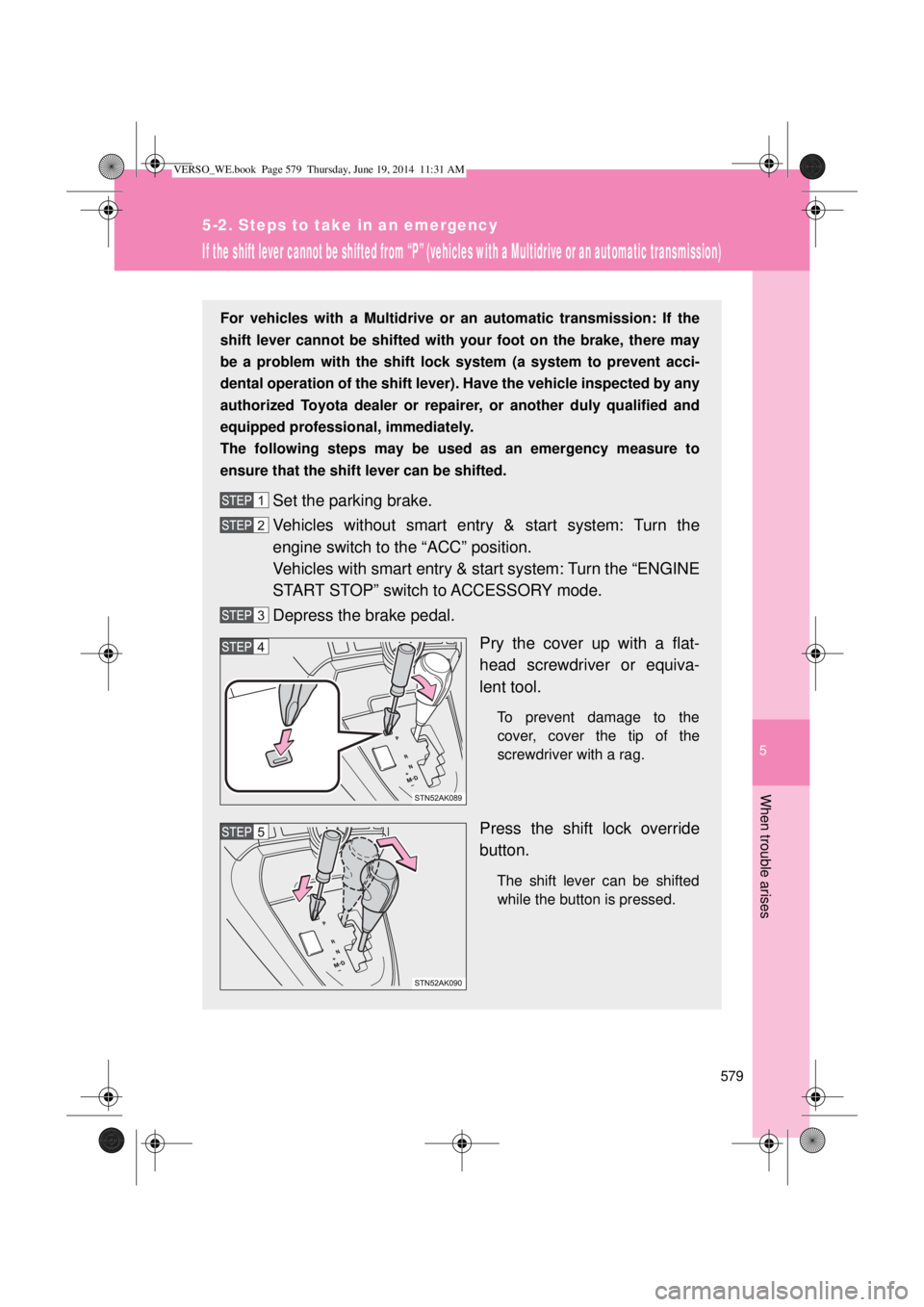
5
579
5-2. Steps to take in an emergency
When trouble arises
If the shift lever cannot be shifted from “P” (vehicles with a Multidrive or an automatic transmission)
For vehicles with a Multidrive or an automatic transmission: If the
shift lever cannot be shifted with your foot on the brake, there may
be a problem with the shift lock system (a system to prevent acci-
dental operation of the shift lever). Have the vehicle inspected by any
authorized Toyota dealer or repairer, or another duly qualified and
equipped professional, immediately.
The following steps may be used as an emergency measure to
ensure that the shift lever can be shifted.
Set the parking brake.
Vehicles without smart entry & start system: Turn the
engine switch to the “ACC” position.
Vehicles with smart entry & start system: Turn the “ENGINE
START STOP” switch to ACCESSORY mode.
Depress the brake pedal.
Pry the cover up with a flat-
head screwdriver or equiva-
lent tool.
To prevent damage to the
cover, cover the tip of the
screwdriver with a rag.
Press the shift lock override
button.
The shift lever can be shifted
while the button is pressed.
VERSO_WE.book Page 579 Thursday, June 19, 2014 11:31 AM